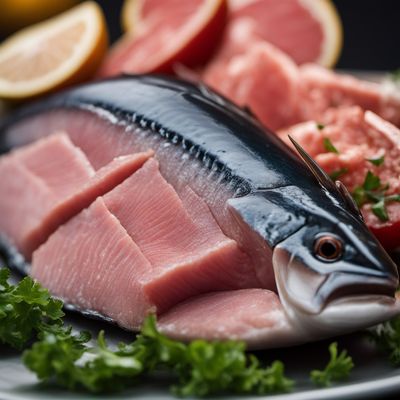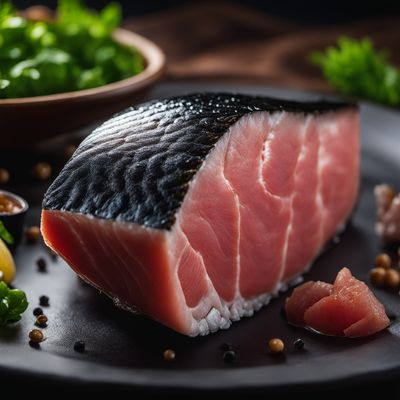
Ingredient
Albacore
The Mighty Albacore
Albacore is a species of tuna that is characterized by its pale pink to white flesh and large size. It has a mild, slightly sweet flavor and a firm, meaty texture. The flesh is tender and flakes easily when cooked, making it ideal for grilling, searing, or baking. Its appearance is marked by its sleek, streamlined body and metallic blue-black back, with a silvery-white belly.
Origins and history
Albacore tuna is native to the warm waters of the Pacific Ocean, particularly the western and central regions. It has been an important food source for many coastal communities, including those in Japan, the United States, and Mexico. Albacore fishing has a long history, with evidence of its consumption dating back thousands of years. It is highly valued in Japanese cuisine, where it is known as shiro maguro, and is a popular choice for sushi and sashimi. In the United States, albacore is commonly used in canned tuna products.
Nutritional information
Albacore is a rich source of protein, omega-3 fatty acids, and essential vitamins and minerals. It is low in saturated fat and calories, making it a healthy choice for those looking to incorporate more seafood into their diet.
Allergens
May contain fish allergens.
How to select
When selecting albacore, look for firm, shiny flesh that is free from any discoloration or strong odor. The skin should be intact and have a vibrant color. If purchasing canned albacore, choose products that are packed in water or olive oil for the best quality.
Storage recommendations
To maintain its freshness, store fresh albacore in the refrigerator at a temperature between 32°F and 38°F (0°C and 3°C). If canned, store in a cool, dry place away from direct sunlight. Once opened, refrigerate any unused portion and consume within 2-3 days.
How to produce
Albacore tuna is typically caught using longline fishing methods, which involve setting lines with baited hooks. It can also be farmed in some regions, although wild-caught albacore is generally considered to be of higher quality. To produce albacore at home, you would need access to a large body of saltwater and the necessary fishing equipment or the means to set up a fish farm.
Preparation tips
Albacore can be prepared in a variety of ways, including grilling, searing, baking, or poaching. It is commonly used in sushi, sashimi, salads, sandwiches, and pasta dishes. To enhance its flavor, marinate the fish in a mixture of soy sauce, ginger, garlic, and sesame oil before cooking. When grilling or searing, cook the fish until it is opaque and flakes easily with a fork. Avoid overcooking, as it can result in a dry texture.
Culinary uses
Albacore is commonly used in sushi, sashimi, poke bowls, and canned tuna products. It is also a popular choice for salads, sandwiches, and pasta dishes. Its mild flavor and firm texture make it a versatile ingredient that can be paired with a wide range of flavors and ingredients.
Availability
Albacore is commonly available in countries with access to the Pacific Ocean, including Japan, the United States, Mexico, and Canada.
More ingredients from this category

Tuna, bluefin (generic)
The Jewel of the Sea: Exploring the World of Bluefin Tuna

Tuna, yellowfin
"The Jewel of the Sea: Exploring the Delights of Yellowfin Tuna"

Tuna, blackfin
The Ocean's Delicacy: Exploring the Richness of Blackfin Tuna

Tuna, bigeye
The Mighty Bigeye Tuna

Tuna, skipjack
The Ocean's Bounty

Tuna, longtail
The Ocean's Swift Hunter

Bullet tuna
The Speedy Predator
